1. INTRODUCTION
Recently, as the interest in improving the quality of life has heightened, demand for control of the noise in residential environment has significantly increased because environmental noise was becoming more serious problem. (Kim et al., 2012; Kim, 2007; Kook et al., 2007; Lee et al., 2011; Hwang et al., 2013) Accordingly, the number of studies on the building materials with excellent sound absorption performance and on measurement of sound absorption has been increasing. (Jang et al., 2018; Kang et al., 2018a; Kang et al., 2019; Kang et al., 2011; Kang et al., 2018c) In addition, worldwide interest in recycling byproducts has been increasing because demand and supply instability of industrial resources and demand of greenhouse gas reduction as climate changing. Especially for Korea, due to the lack of natural resources, effective reuse technology of various industrial by-products is needed in order to save as much as resources.
The mechanism of sound absorption is to deplete or reduce the energy of sound, resulting in reducing reverberation and controlling reverberation time. Sound absorption materials should have high acoustic absorptivity and also have no or less a harmful effect on humans. The insulation of sound could be presented by the sound transmission loss computed from the ratio of transmitted sound energy vs. incident sound energy. The sound transmission loss could be measured by both of transfer matrix method and reverberation room method. The transfer matrix method using an impedance tube has the advantage of quick measurement over wide frequency range. The reverberation room method has the advantage of accurate measurement, but needs large spaces and specimens.
About 80 million tons of rice hulls are produced each year in Korea and most of them are consumed for low value-added livestock facilities. In this study, to evaluate the possibility of using rice hull mats as acoustic construction materials, sound absorption coefficient and sound transmission loss of various target densities and thicknesses of rice hull mats were measured by using transfer function method and transfer matrix method. They were compared with those values of the samples plywood attached to their back sides. Feasibility of applying the samples to interior building material was examined.
2. MATERIALS and METHODS
The apparent density of rice hull mats was reached through regulation of pressing pressure of a knob on the back side of sample holder after weighed amount of rice hulls were put into an impedance tube. A circular net was installed in front of the holder to prevent to rice hulls flow down by the gravity of rice hulls as shown in Fig. 2.
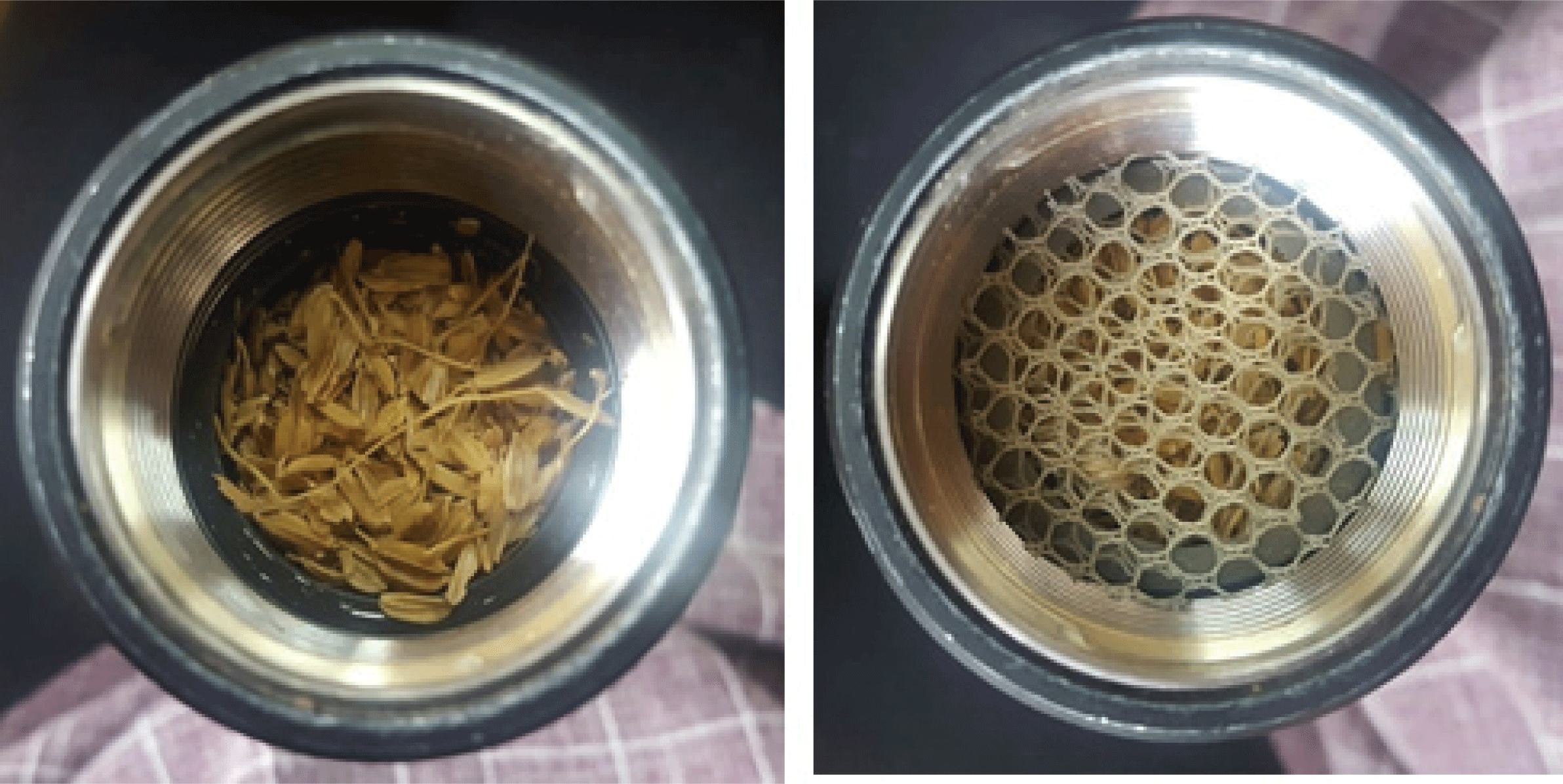
The sound absorption rate in practical frequency range was measured by transfer function method (ISO 10534-2) using impedance tube, pulse analysis software and a spectrum analyzer (B&K Company) as precious research (Kang et al., 2012). In this study, the variation of sound absorption rate was measured as change of frequency in the range of 100 Hz~6400Hz using the impedance tube with the diameter of 29 mm. During measurement, temperature, relative humidity and atmospheric pressure were 26.4 °C, 68 percent and 1027.00 hPa, respectively. The velocity of sound, air density and acoustic impedance were 346.98 m/s, 1.192 kg/m3 and 413.7 Pa/(m/s), respectively.
The sound transmission coefficient, τ, of a material is defined as the ratio of sound power transmitted per incident sound power expressed as follows,
Where
Wi is incident sound power
Wt is transmitted sound power
The sound transmission loss, STL, of a material is measured in decibels expressed as follows,
The sound transmission loss of specimens was measured by transfer matrix method (ASTM E2611 – 09) using impedance tube for estimating transmission loss (Fig. 1, B&K Company), pulse analysis software and a spectrum analyzer (B&K company) as precious research (Kang et al., 2018b). The estimation frequency range was 100~6400Hz. During measurement, temperature and atmospheric pressure were 24.4 °C and 1027.5 hPa, respectively.

3. RESULTS and DISCUSSION
As shown in Fig. 3, the sound absorption rates of rice hull mat with apparent density of 0.10 measured by transfer function method showed in the range of 100 Hz~6400 Hz. As the thickness of specimens increased from 20mm to 30mm, 50mm, 80mm and 100mm, average sound absorption rates was 0.53, 0.67, 0.76, 0.87 and 0.91, which indicates that average sound absorption rate increases as the thickness of specimens increasing. The frequency at which, sound absorption rate significantly increased, first peak occurred was 2912, 2120, 1200, 760 and 584 Hz, at this time sound absorption rate was 0.80, 0.82, 0.84, 0.95 and 0.96.
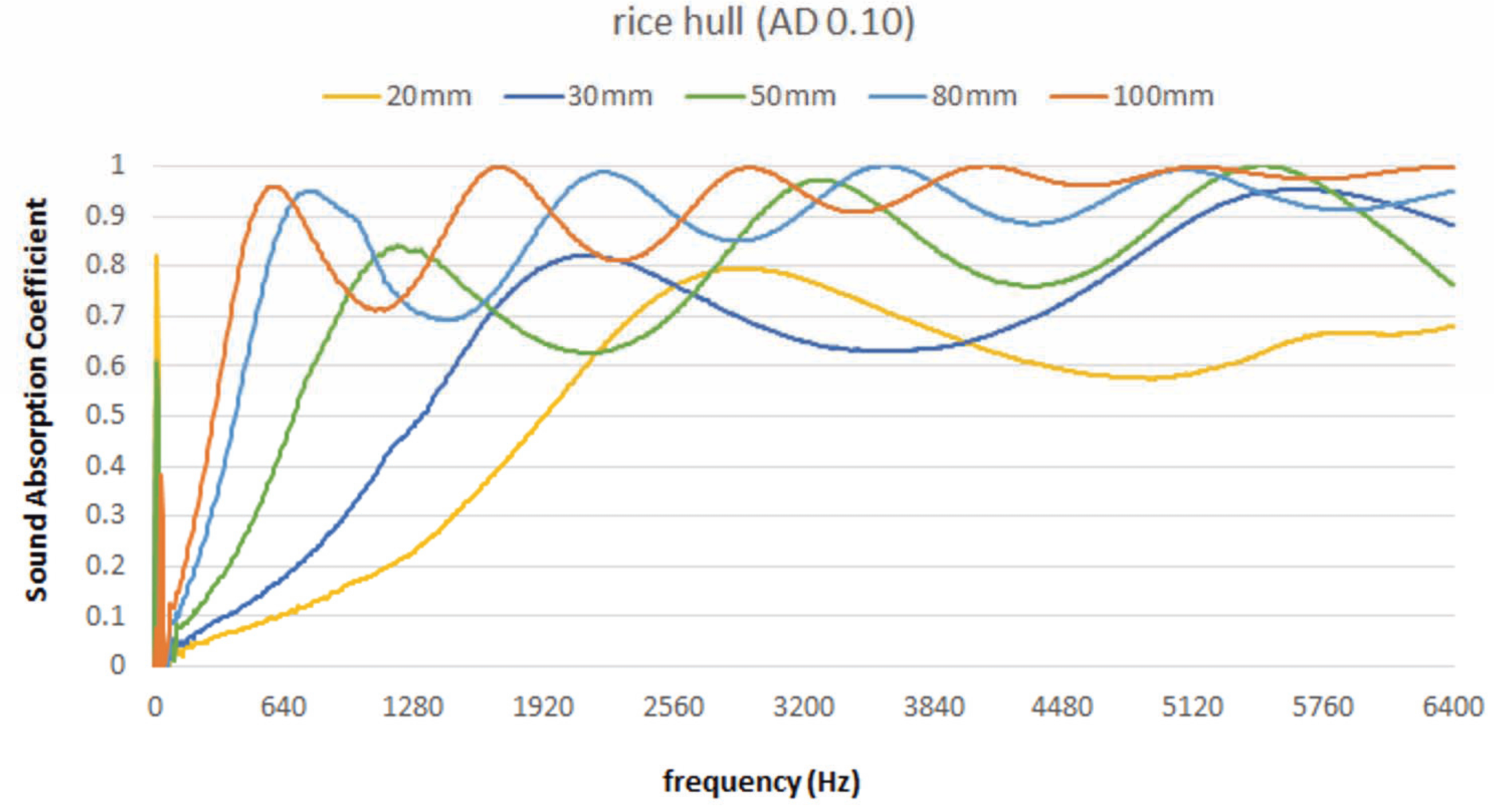
As shown in Fig. 4, the sound absorption rates of rice hull mat with apparent density of 0.12 measured by transfer function method showed in the range of 100 Hz~6400 Hz. As the thickness of specimens increased from 20mm to 30mm, 50mm, 80mm and 100mm, average sound absorption rates was 0.61, 0.67, 0.83, 0.89 and 0.92, which indicates that average sound absorption rate increases as the thickness of specimens increasing. The frequency at which, sound absorption rate significantly increased, first peak occurred was 2720, 1792, 1080, 664 and 504 Hz, at this time sound absorption rate was 0.84, 0.72, 0.99, 0.997 and 0.999.
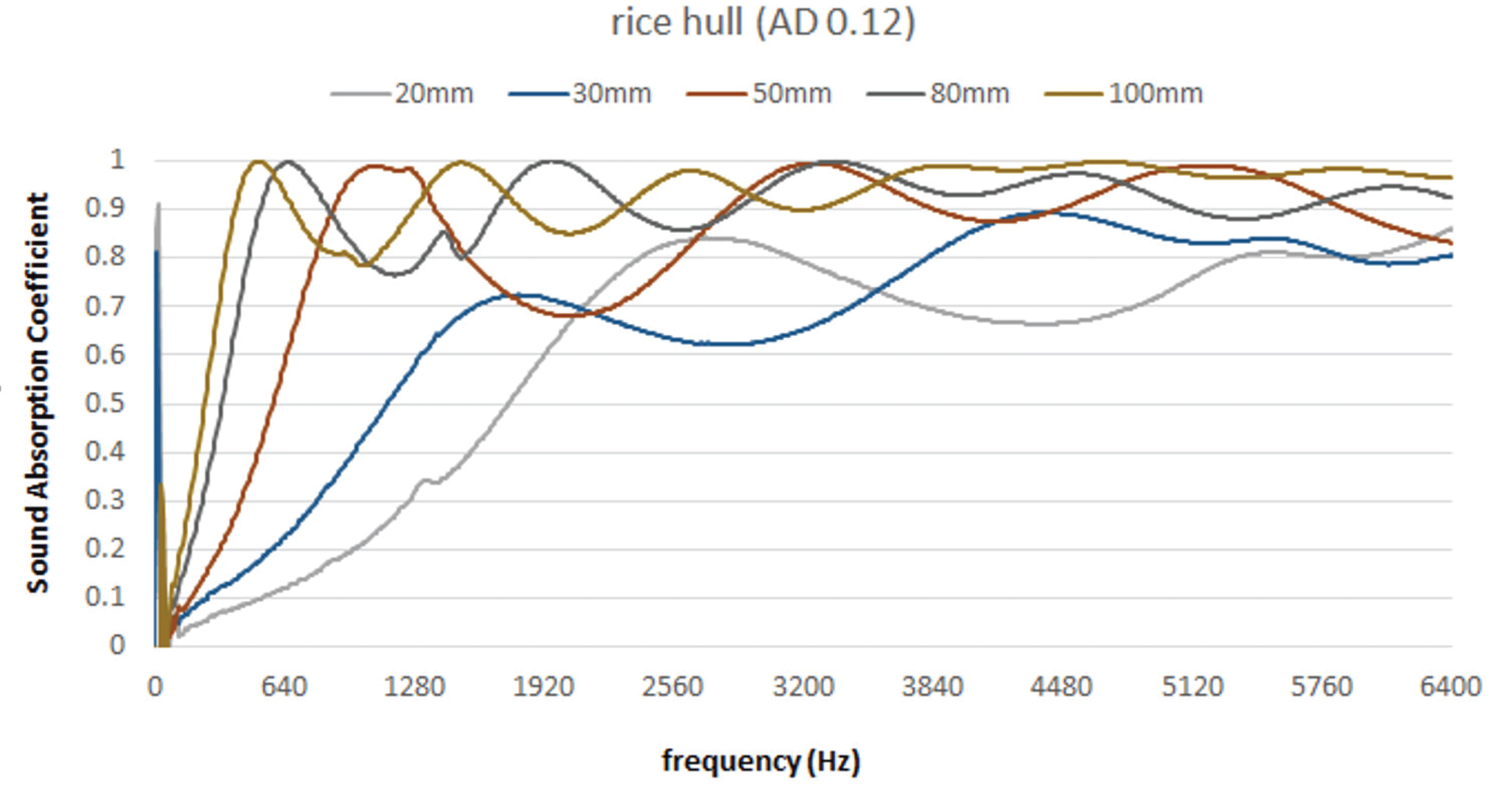
As shown in Fig. 5, the sound absorption rates of rice hull mat with apparent density of 0.14 were measured by transfer function method in the range of 100 Hz~6400 Hz. As the thickness of specimens increased from 20mm to 30mm, 50mm, 80mm and 100mm, average sound absorption rates was 0.64, 0.76, 0.86, 0.90 and 0.95. It could be concluded that average sound absorption rate increases with the thickness of specimens. When sound absorption rates significantly increased, the frequencies at the first peaks were 2160, 1744, 1048, 592 and 496 Hz, and their corresponding sound absorption rates were 0.94, 0.97, 0.999, 0.994 and 0.999.
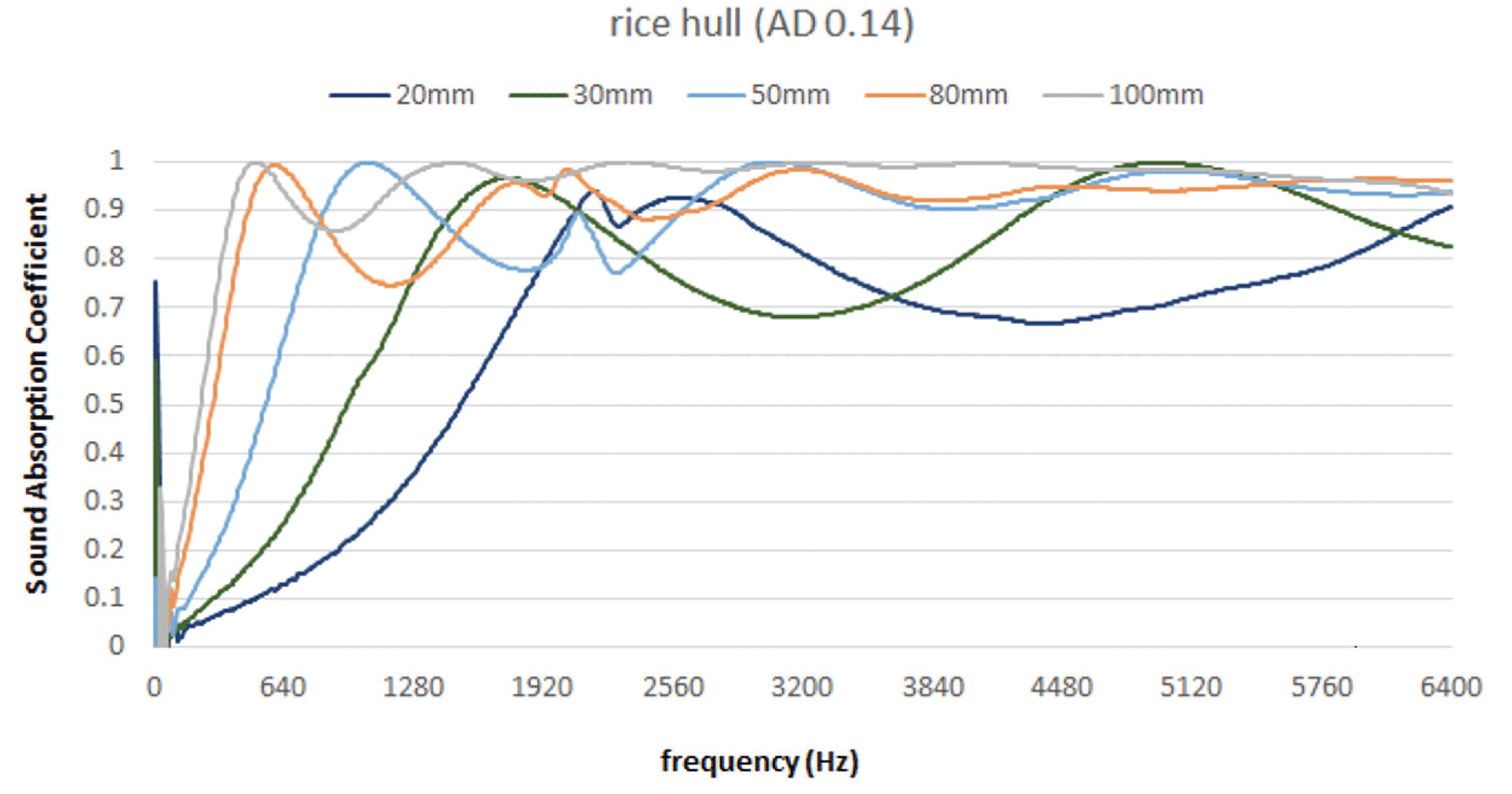
As shown in Fig. 6, the sound absorption rates of the specimens which were 10mm thick plywood attached the back of rice hull mat with apparent density of 0.10 measured by transfer function method are shown in the range of 100 Hz~ 6400 Hz. As the thickness of specimens increased from 20mm to 30mm, 50mm, 80mm and 100mm, average sound absorption rates were 0.54, 0.70, 0.80, 0.85 and 0.90, which indicates that average sound absorption rate increases as the thickness of specimens increases. The frequency at which, sound absorption rate significantly increased, first peak occurred was 3120, 2080, 1312, 712 and 624 Hz, at this time sound absorption rate was 0.73, 0.89, 0.92, 0.92 and 0.93.
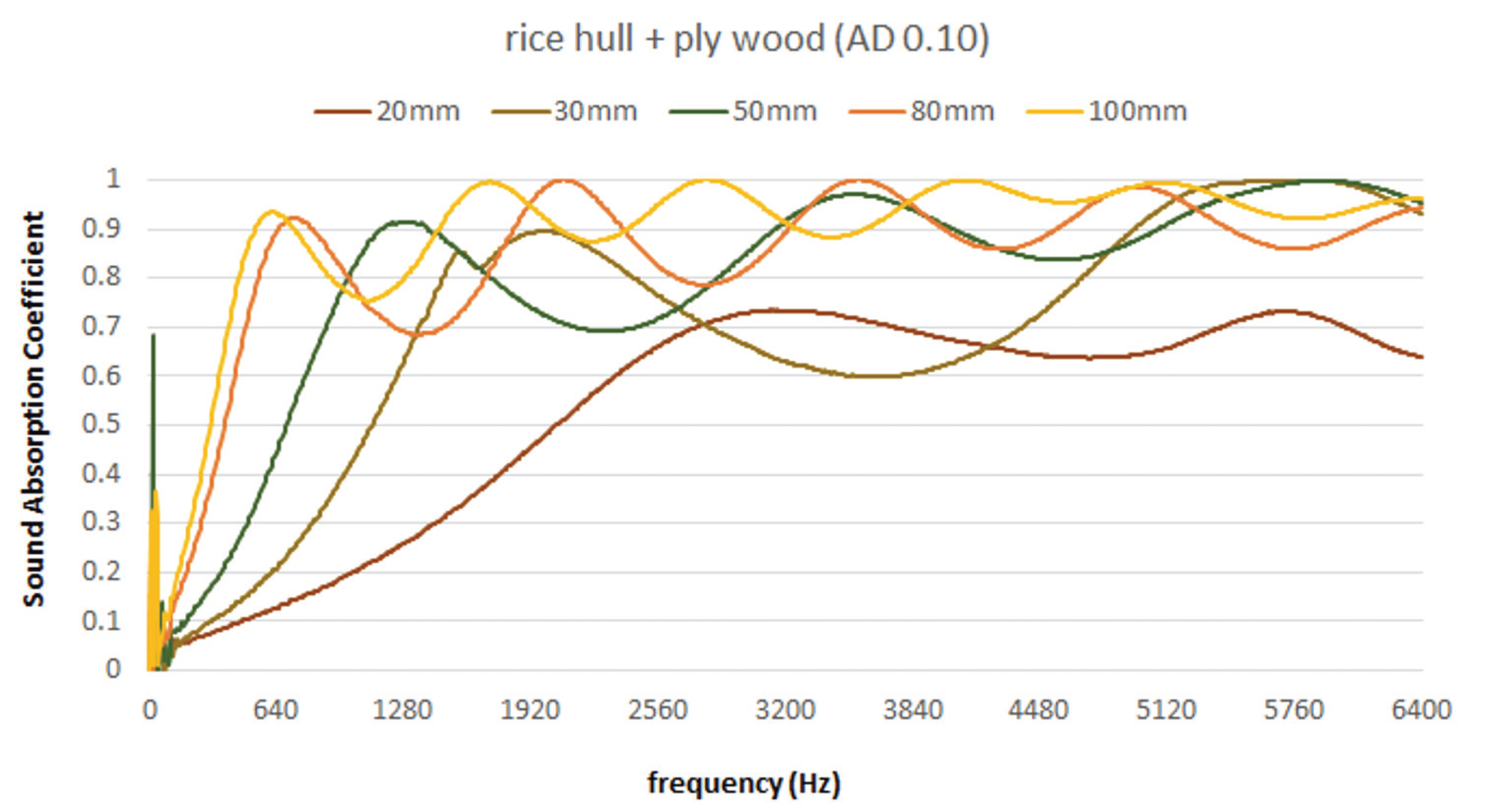
As shown in Fig. 7, the sound absorption rates of the specimens which were 10mm thick plywood attached the back of rice hull mat with apparent density of 0.12 measured by transfer function method are shown in the range of 100 Hz~6400 Hz. As the thickness of specimens increased from 20mm to 30mm, 50mm, 80mm and 100mm, average sound absorption rates was 0.62, 0.74, 0.84, 0.90 and 0.92, which indicates that average sound absorption rate increases as the thickness of specimens increasing. The frequency at which, sound absorption rate significantly increased, first peak occurred was 2520, 1548, 1024, 632 and 496 Hz, at this time sound absorption rate was 0.96, 0.99, 0.98, 0.99 and 0.99.
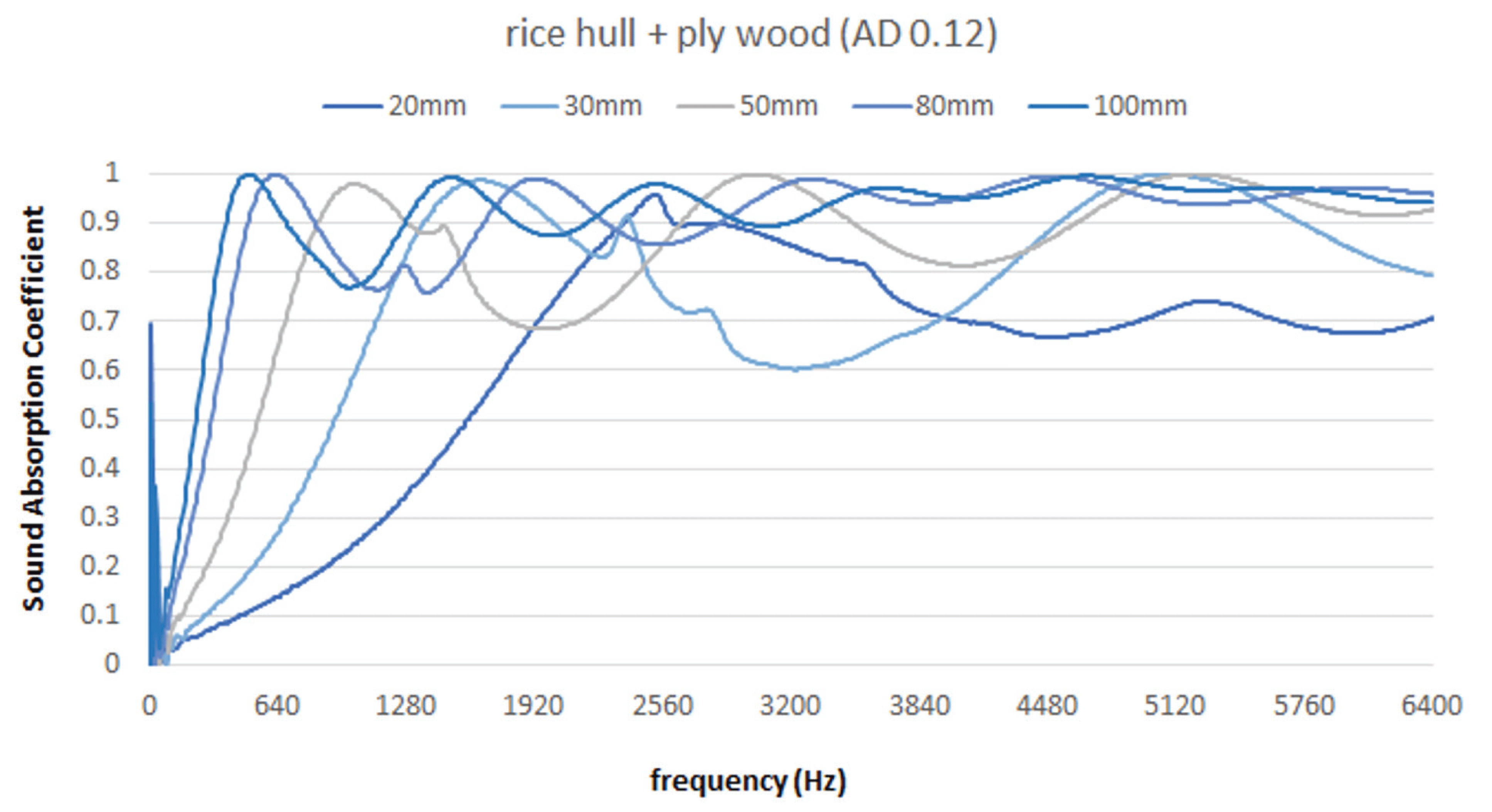
As shown in Fig. 8, the sound absorption rates of specimens which were 10mm thick plywood attached the back of rice hull mat with apparent density of 0.14 measured by transfer function method are shown in the range of 100 Hz~6400Hz. As the thickness of specimens increased from 20mm to 30mm, 50mm, 80mm and 100mm, average sound absorption rates was 0.70, 0.79, 0.87, 0.89 and 0.92, which indicates that average sound absorption rate increases as the thickness of specimens increases. The frequency at which, sound absorption rate significantly increased, first peak occurred was 2352, 1584, 968, 544 and 432 Hz, at this time sound absorption rate was 0.99, 0.99, 0.999, 0.99 and 0.98.
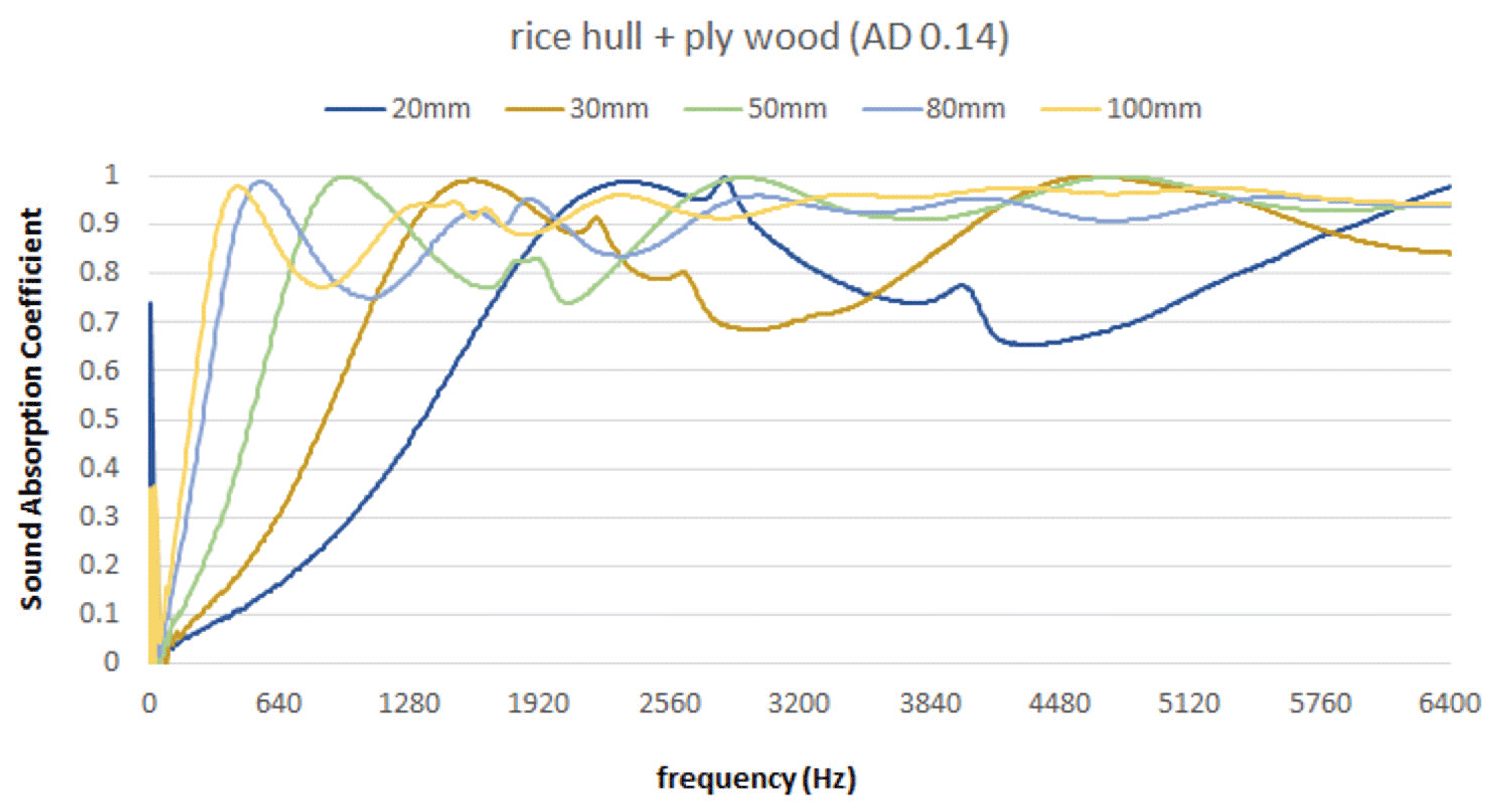
As a whole, average sound absorption rate of rice hull mats presents an increasing trend as the thickness of specimens increases and the frequency at which first peak occurred decreases while sound absorption rate increases as the thickness of specimen increases. The average sound absorption rate was 0.54 - 0.92 for 10mm thick plywood attached the back of rice hull mats and 0.53 - 0.95 for rice hull mats, which was 1% lower than that for rice hull mats. Especially, The average sound absorption rate was 0.93 for 10mm thick plywood attached the back of rice hull mats and 0.95 for rice hull mats when the thickness of specimens was 100mm in the range of 100 Hz~6400 Hz. On the other hand, the noise reduction coefficient of the gypsum board usually used for ceiling in office or classroom presented about 0.30 while that value of 10 cm thick rice hull mat with the density of 0.14 g/cm3 in this study presented about 0,35, which was better than the former.
The acoustic transmission loss of rice hulls and rice hull mats is shown in Fig. 9 when the densities were 0.1, 0.12 and 0.14, and the thickness of specimens was 100mm. When the density was 0.1, the acoustic transmission loss was 4.26 dB between the frequency range of 100 Hz~500 Hz, 5.56 dB between the frequency range of 500 Hz~1000Hz and 8.11 dB between the frequency range of 1000 Hz~6400Hz. Their average value was 7.66 dB. When the density was 0.12, the acoustic transmission loss was 6.06 dB between the frequency range of 100 Hz~500Hz, 7.28 dB between the frequency range of 500 Hz~1000Hz and 11.12 dB between the frequency range of 1000 Hz~6400 Hz, average value being 10.49 dB. When the density was 0.14, the acoustic transmission loss was 8.24 dB between the frequency range of 100 Hz~ 500 Hz, 9.23 dB between the frequency range of 500 Hz~1000Hz and 15.03 dB between the frequency range of 1000 Hz~6400Hz, average value being 14.14 dB. Although sound insulation performance of rice hull mats was low because sound pass through among the particles, the sound insulation performance increased by 1.85 times (6.48 dB) as the density increased from 0.1 to 0.14.
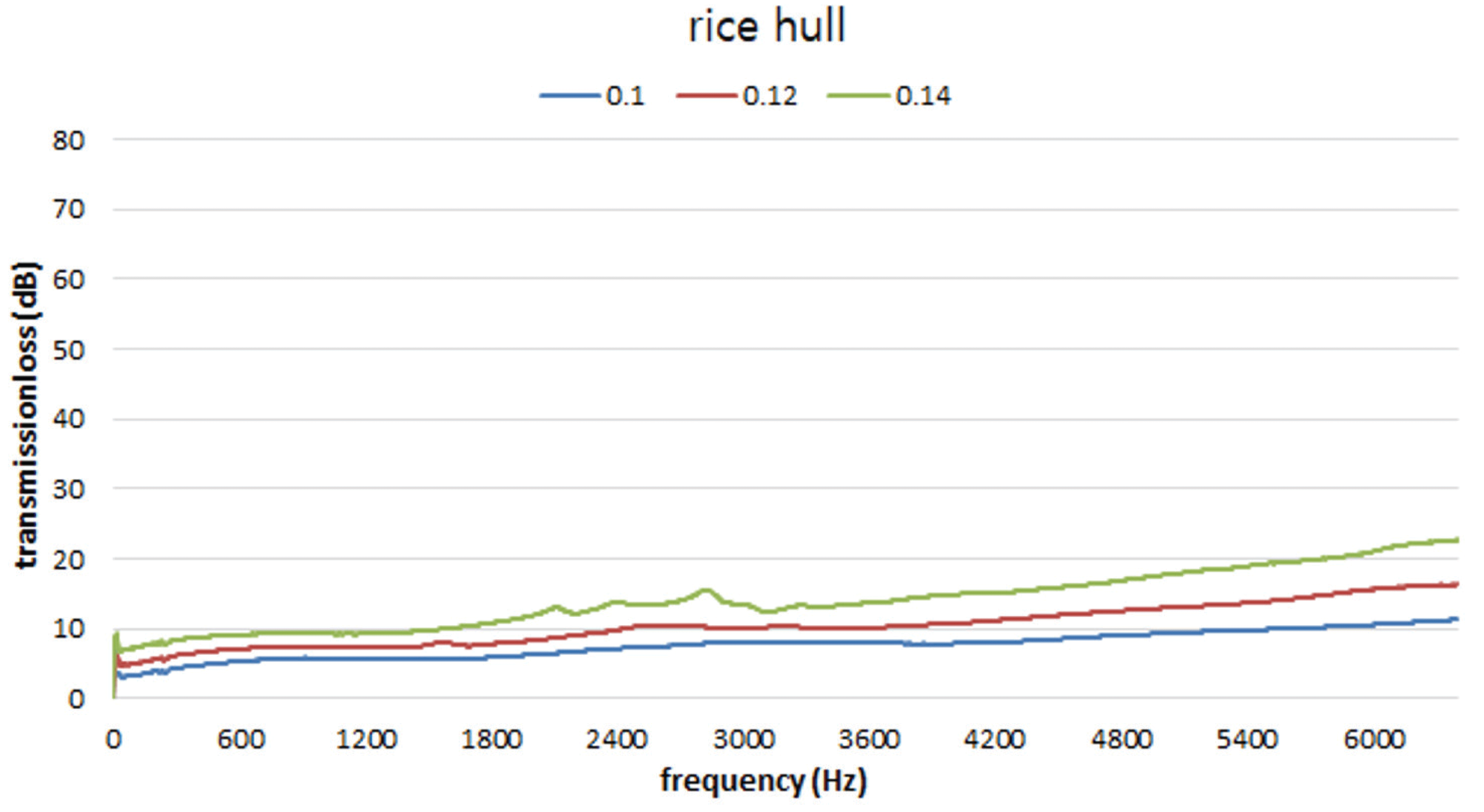
The sound transmission loss of 10mm thick plywood attached the back of rice hulls is shown in Fig. 9. The sound transmission loss was significantly increased because the sound transmission loss was proportional to the surface density of the specimens.
The sound transmission loss was 25.08 dB between the frequency range of 100 Hz ~ 500 Hz, 25.55 dB between the frequency range of 500 Hz~1000 Hz and 34.67 dB between the frequency range of 1000 Hz~6400 Hz, average value being 33.34 dB, when the density was 0.1. When the density was 0.12, sound transmission loss was 26.99 dB between the frequency range of 100 Hz~500 Hz, 27.86 dB between the frequency range of 500 Hz~1000 Hz and 38.26 dB between the frequency range of 1000 Hz~6400 Hz. Their average value was 36.72 dB. When the density was 0.14, acoustic transmission loss was 26.55 dB between the frequency range of 100 Hz~500 Hz, 29.19dB between the frequency range of 500 Hz~1000 Hz and 40.77 dB between the frequency range of 1000 Hz~6400 Hz, average value being 38.95 dB. Fig. 10.
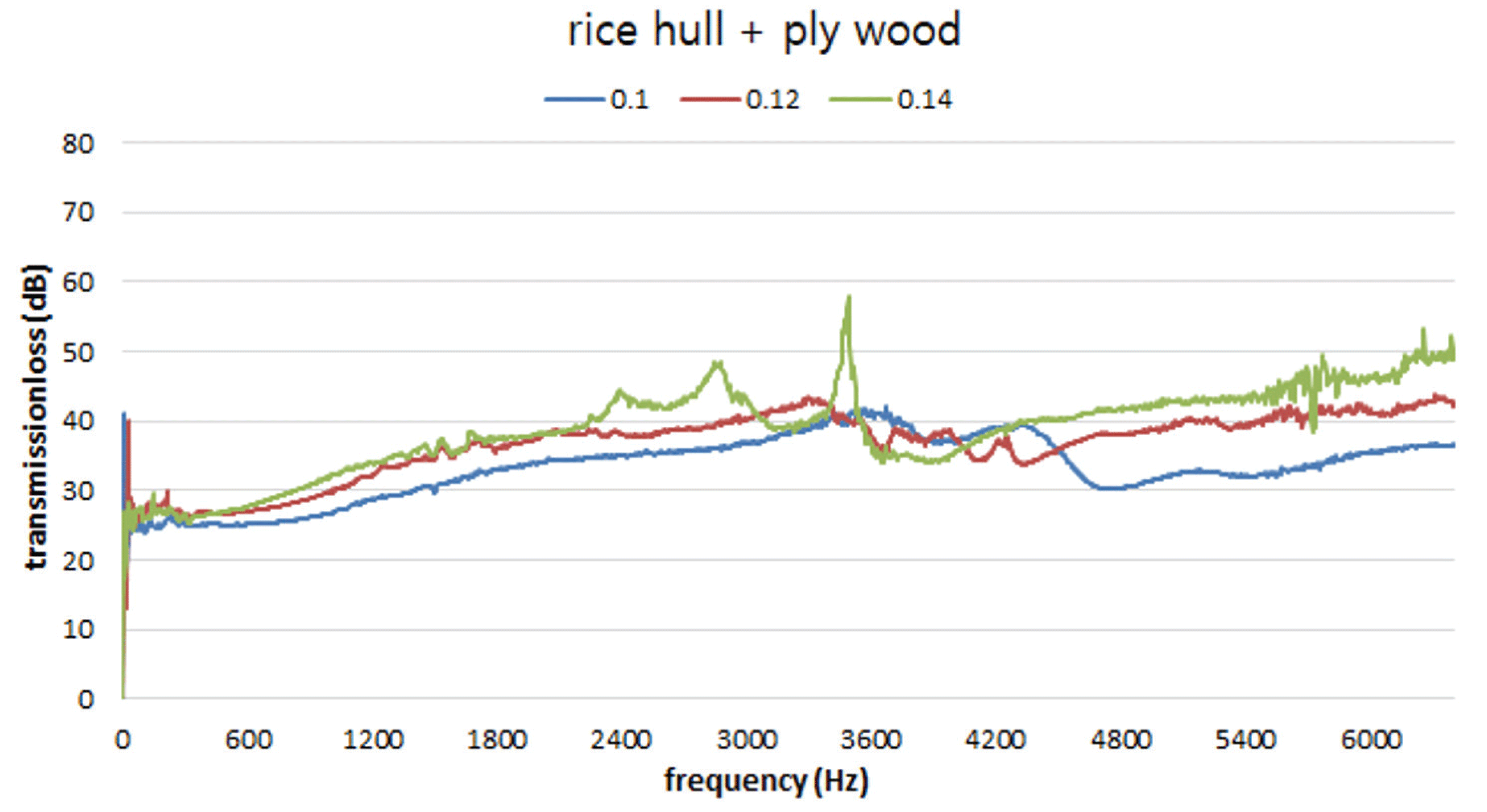
Although sound insulation performance of rice hull mats was low because sound pass through among the particles, the sound insulation performance increased by 1.17 times (5.61 dB) as the density increased from 0.1 to 0.14.
The acoustic transmission loss of rice hulls generally presented lower value because the density of thin rice hulls was low in this study. The acoustic transmission loss showed an increasing trend as frequency increases, and presented low value, being 4 – 12 dB, which was difficult to expect to have good acoustic isolation effect. However, acoustic transmission loss of rice hulls attached plywood increased, being 25 – 50 dB.
4. CONCLUSION
The sound absorption coefficient and sound transmission loss of different apparent densities with 0.10, 0.12 and 0.14 and thicknesses of 2 cm, 4 cm, 6 cm, 8 cm and 10 cm rice hull mats were measured and compared to those values of 1 cm thick plywood attached rice hull mats, in this study.
The sound absorption coefficient of rice hull mats was increased with the target density and mat thickness. Its mean value of 10 cm thick rice hull mats with the target density of 0.14 was 0.99, was higher than that of 1.1 cm thick commercial gypsum board. It was possible that rice hull mats was used as sound-absorbing materials. There are almost no difference between rice hull mats and plywood attached rice hull mats.
The sound transmission loss of rice hull mats were 4-9 dB while sound transmission loss of plywood attached rice hulls was 25 - 40 dB.
The 1 cm thick plywood attached 10 cm thick rice hulls mats with the target density of 0.14 was expected to use as acoustic construction materials due to its highly sound absorbing and good acoustic isolation performance.








